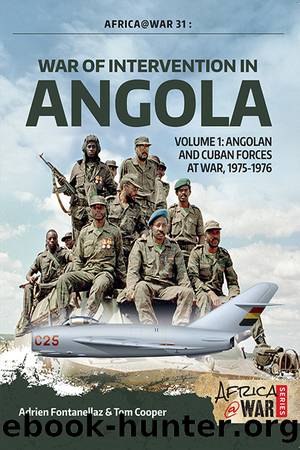War of Intervention in Angola. Volume 1 by Tom Cooper Adrien Fontanellaz

Author:Tom Cooper, Adrien Fontanellaz [Tom Cooper, Adrien Fontanellaz]
Language: eng
Format: epub
ISBN: 9781911628194
Barnesnoble:
Publisher: Helion and Company
Published: 2018-10-23T00:00:00+00:00
Originally, Moscow was neither keen nor ready to deploy its military personnel directly to Angola. However, this standpoint âhad to changeâ as ever larger numbers of Cuban troops arrived there. Indeed, once Carlota began, the Soviets decided to deploy their military instructors to Congo-Brazzaville, too. On 1st November, a small team under Captain Evgeny Lyashenko arrived in Brazzaville aboard an Aeroflot flight. Prior to its arrival at Pointe Noire, the task for Lyashenkoâs team was to teach FAPLA in the use of Strela MANPADS. Instead, its first group of students consisted of Cuban specialists â those that arrived in Brazzaville on 6 November, as described above.
Due to growing demands for instructors in Angola, the Soviet team was increased to 40 â meanwhile led by Colonel Vassily Trofimenko â and then transferred from Pointe Noire to Luanda with the help of an Antonov An-12 transport of the Aeroflot, on 16 November 1975.100
Subsequently, Moscowâs stance in regards of Operation Carlota continued changing. Indeed, in January 1976 it experienced a dramatic expansion: insisting all of these were to be used by the FAR troops only, the Soviets delivered 73 additional tanks and 21 BM-21 MRLs, followed by immense stocks of fire-arms, ammunition, equipment and supplies â directly to Angola. Furthermore, and starting with 7 January 1976, Aeroflot launched daily flights on the route Havana â Conakry â Luanda, using Ilyushin Il-62 jet airliners to transport Cuban troops to Angola. With Soviet help, the flow of the Cuban deployment came forward at amazing speed: while the FAR only managed to deploy between 3,500 and 4,000 of its troops in the country by 31 December 1975, three months later it had 36,000 â in great part thanks to Soviet transport aircraft.101
Download
This site does not store any files on its server. We only index and link to content provided by other sites. Please contact the content providers to delete copyright contents if any and email us, we'll remove relevant links or contents immediately.
| Central Africa | East Africa |
| North Africa | Southern Africa |
| West Africa | Algeria |
| Egypt | Ethiopia |
| Kenya | Nigeria |
| South Africa | Sudan |
| Zimbabwe |
Goodbye Paradise(3455)
Men at Arms by Terry Pratchett(2685)
Tobruk by Peter Fitzsimons(2376)
Arabs by Eugene Rogan(2196)
Pirate Alley by Terry McKnight(2128)
Borders by unknow(2119)
Belonging by Unknown(1732)
It's Our Turn to Eat by Michela Wrong(1593)
The Biafra Story by Frederick Forsyth(1560)
Botswana--Culture Smart! by Michael Main(1484)
The Source by James A. Michener(1459)
A Winter in Arabia by Freya Stark(1447)
Gandhi by Ramachandra Guha(1433)
Coffee: From Bean to Barista by Robert W. Thurston(1420)
Livingstone by Tim Jeal(1394)
The Falls by Unknown(1372)
The Shield and The Sword by Ernle Bradford(1312)
Africa: Altered States, Ordinary Miracles by Richard Dowden(1296)
Egyptian Mythology A Fascinating Guide to Understanding the Gods, Goddesses, Monsters, and Mortals (Greek Mythology - Norse Mythology - Egyptian Mythology) by Matt Clayton(1278)
